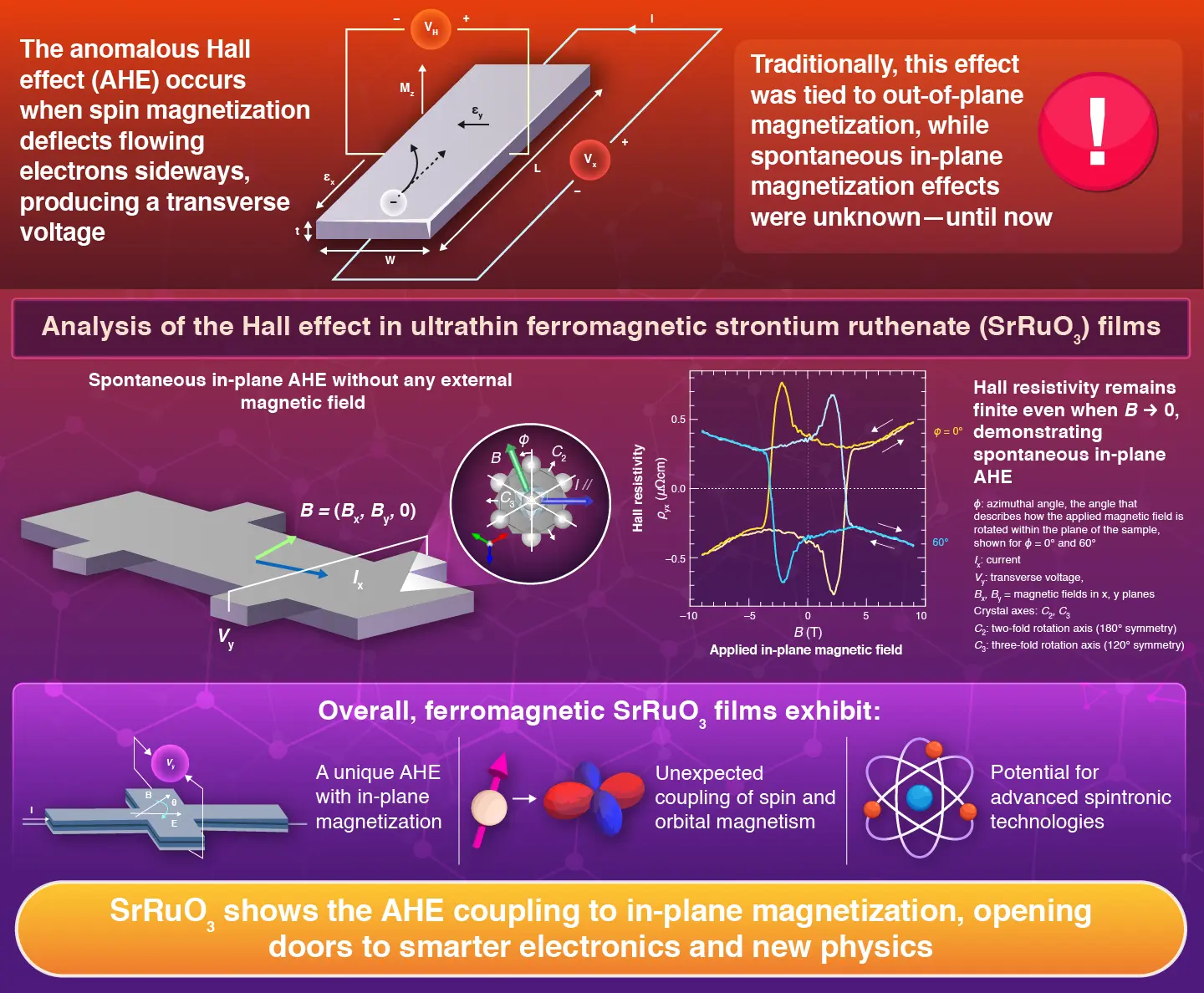In a recent breakthrough, researchers from Japan discovered a unique Hall effect resulting from deflection of electrons due to "in-plane magnetization" of ferromagnetic oxide films (SrRuO3). Arising from the spontaneous coupling of spin-orbit magnetization within SrRuO3 films, the effect overturns the century-old assumption that only out-of-plane magnetization can trigger the Hall effect. The study offers a new way to manipulate electron transport with potential applications in advanced sensors, quantum materials, and spintronic technologies.
New Hall Effect Discovery in Ferromagnetic SrRuO3 Films

Nishihaya et al. (2025) | Advanced Materials | 10.1002/adma.202502624
When an electric current flows through a material in the presence of a magnetic field, its electrons experience a subtle sideways force which deflects their path. This effect of electron deflection is called the Hall effect—a phenomenon that lies at the heart of modern sensors and electronic devices. When this effect results from internal magnetization of the conducting material, it is called "anomalous Hall effect (AHE)." Scientists have long believed that the Hall effect only emerges when magnetization is pointed out of the plane of electron flow, but a recent study from Japan challenges this assumption!
The study led by Associate Professor Masaki Uchida at the Department of Physics, Institute of Science Tokyo (Science Tokyo), Japan, in collaboration with Associate Professor Hiroaki Ishizuka from the same department and Professor Ryotaro Arita from the Graduate School of Science, The University of Tokyo, demonstrates that an AHE can occur even when the magnetization lies entirely within the plane of electron flow. The effect was observed in an ultrathin film of strontium ruthenate (SrRuO3), a ferromagnetic oxide, which can be magnetized and retain its magnetism. The findings were published in the journal of Advanced Materials on September 16, 2025.
The researchers started by growing nanometer-scale films of SrRuO3, which was chosen due to its unique structure that hosts Weyl points—singular points in the electronic band structure where the electronic bands intersect in three dimensions. The crystalline orientation of the films was carefully controlled to create a state with spontaneous in-plane spin magnetization (resulting from the alignment of electron spins).
Surprisingly, they found that the system exhibited a large AHE even without applying any external magnetic field. This response was driven by orbital magnetization, which arises from the orbital motion of electrons.
"This spontaneous AHE was observed in a system where it was long thought impossible," says Uchida, highlighting the crucial role of orbital magnetization.
To analyze further, the team systematically measured Hall resistivity, which measured the sideways voltage in the material under different polar and azimuthal angles of the applied magnetic field. The polar angles define the magnetic field's tilt from vertical, while the azimuthal angles show the direction of magnetic field across the plane. Varying these angles resulted in changes in the resistivity revealing how the Hall response depends sensitively on the orientation of spin magnetization. These experiments further confirmed that the effects arouse from an off-diagonal coupling between spin and orbital magnetizations.
"These insights reveal how subtle distortions in the crystal structure can influence higher-order interactions, giving rise to unexpected electronic behaviors," explains Uchida.
This groundbreaking discovery not only redefines our understanding of the Hall effect but also highlights electronic behaviors that could transform the material science. By harnessing orbital magnetization for in-plane Hall response, the study opens new avenues for designing materials like magnetic sensors with tailored electronic properties. Insights from this study could also prove valuable for spintronic technologies, which use electron spin to store and process information.
Looking ahead, the researchers plan to explore other materials and geometries for similar effects. By further extending these Hall effect principles in engineered quantum materials, researchers may uncover even richer electronic behaviors—paving the way for next-generation electronic devices.
Reference
- Authors:
- Shinichi Nishihaya1, Yuta Matsuki1, Haruto Kaminakamura1, Hiroki Sugeno1, Ming-Chun Jiang2,3 Yoshiya Murakami1, Ryotaro Arita2,4, Hiroaki Ishizuka1, and Masaki Uchida1,5*
*Corresponding author
- Title:
- Spontaneous in-plane anomalous Hall response observed in a ferromagnetic oxide
- Journal:
- Advanced Materials
- Affiliations:
- 1Department of Physics, Institute of Science Tokyo, Japan
2RIKEN Center for Emergent Matter Science, Japan
3Department of Physics and Center for Theoretical Physics, National Taiwan University, Taiwan
4Department of Physics, University of Tokyo, Japan
5Toyota Physical and Chemical Research Institute, Japan






